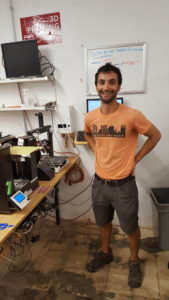Is a Maker Lab in Norfolk’s Future?
Local group explores the possibility on a field trip to New Haven
By Karen Rossi
In New Haven there is a special scent to the air in early fall. It’s born from the rustling leaves of the tree-lined streets, the cool nights and hot days mixed with a bit of salt air rolling in from the harbor. Moreover, the air is electrified by the hopes and dreams of thousands of students getting back to school. It was on just such a September day that a group of Norfolkians met at the Yale Center for Engineering Innovation and Design (CEID) to visit its Maker Lab. Pastor Erick Olsen of Norfolk’s Church of Christ, himself a graduate of Yale’s divinity school, had been considering the possibility of organizing a maker space in Norfolk. He had read about the Yale Maker Lab in his alumni newsletter, and was curious to see it, so he enlisted Craig Chung, Ryan Craig, Julie Scharnberg, and me to join him in the quest to learn more.
The maker space concept grew out of a consumer dissatisfaction with products that are assembled en masse in foreign countries. Adweek Magazine describes it as “an umbrella term for independent inventors, designer and tinkerers. It’s a convergence of computer hackers and traditional artisans, catnip for do-it-yourselfers who used to toil in solitude.”

Lior Trestman, chief maker at MakeHaven in New Haven.
The Yale CEID lab was an overwhelming buffet of treats for people who love to build and create. Their laser cutters and 3-D printers were top of the line. Unlike most maker spaces, Yale’s doesn’t rely on donated tools and hand-me-down sewing machines. It’s a state-of-the-art laboratory open to all with active Yale identification cards. Our tour guide, Dante Archangeli, explained the far-reaching use of the workspace. He mentioned that doctors or instructors from the Yale New Haven Hospital often come to the maker space with a concept from which teams of students develop new products. The CEID website touts the maker space as a breeding ground for new ideas: “CEID workshops and training sessions allow members to build skills through fun, hands-on projects […] From undergraduate clubs to hackathons, the CEID supports interdisciplinary activity at all levels.”.
A large classroom and many individual table stations populate the first floor of the lab area, including state-of-the-art machine, metal and wood shops. Electronic musical instruments that had just been made were on display. The top floor had many individual meeting rooms for smaller groups (resembling our own Norfolk Hub).
Following lunch, our other New Haven appointment was to visit MakeHaven—a non-profit, membership-driven community maker space near the intersection of Chapel and State Streets. MakeHaven describes itself as “a community maker space which educates and empowers people by facilitating independent interest-driven projects, hands-on experiences and access to technology.”
At MakeHaven, we were greeted by former Norfolk resident Lior Trestman, whose official title is Chief Maker. At first glance, the space (housed in the basement of an age-old building) was bright and airy, with natural light streaming through the windows, illuminating the brightly painted and lit space. We saw an antique printing press for silk screening, a sewing station, 3-D printers and laser cutters. There was an electronics area which housed a ham radio. Various molds were to be seen in the casting area, and someone had donated sign-making equipment. A full kitchen is available to the members and is often used for cooking/canning workshops. In fact, beer was brewing in beautifully polished stainless steel casks at the time of our visit.
Next, we entered a locked room which housed a full wood shop. Hand tools were displayed on the wall, their shadows painted behind them (so tools would always be put back in the proper spots). Each of the electric tools had a card reader. Only qualified and trained individuals would have access to a tool, using their swipe card. The privilege of using a machine is granted once the proper training is completed, and the swipe card has been updated with the information. Through this process, the use of each tool is documented. Access is granted on a 24-hour basis, but no one can use the power tools without the buddy system.
In another room there were Bridgeport lathes, welding equipment, a sandblaster, benders and rolling machines—a full metal shop. Rentable storage is available for everyone’s projects.
Trestman remarked, “we have grown organically. Like most maker spaces, our shops have taken shape from tools and equipment that were donated, and from the talents of our members.”
The challenge for most community maker spaces is to continue to grow the membership. With rates at $50 a month, the use of the tools is affordable. Locally, KidsPlay Children’s Museum in Torrington has a maker space just for teens, which will be interesting to observe.
The Norfolk representatives who traveled to visit these maker spaces discussed whether a maker space in the Norfolk community might bring folks together to share knowledge, tools and skills, and to pass along information and support. “I was intrigued,” says Olsen, “by the potential of such a space here as an initiative of the work of NorfolkNET. With this community’s unique blend of diverse and creative folks along with a bounty of resources, it seems like a natural fit. I am delighted that there is clear support for the idea of a space that will bring together people of different generations to make more local products in a sustainable, collaborative way. And it should be a blast!”
The smell of the air in Norfolk is the purest! The quest for knowledge, the adventure of education and the possibility to make something great from nothing is here, too. To lend your time and talents to work toward a Norfolk maker space, contact Erick Olsen at reverendole@hotmail.com.
Photo by Julie Scharnberg.
